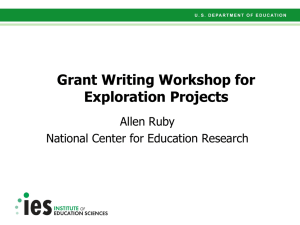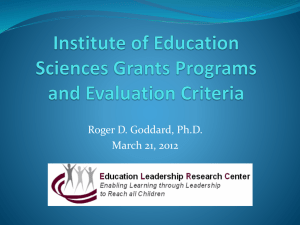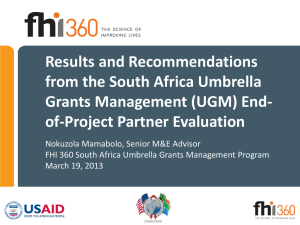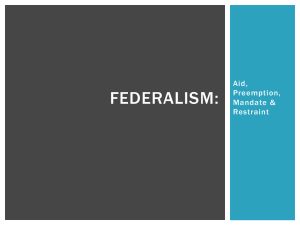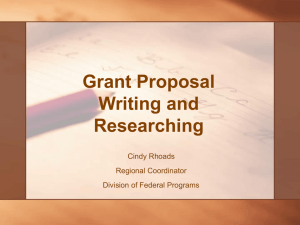Grant Writing Presentation for Exploration Projects (Goal 1)
advertisement
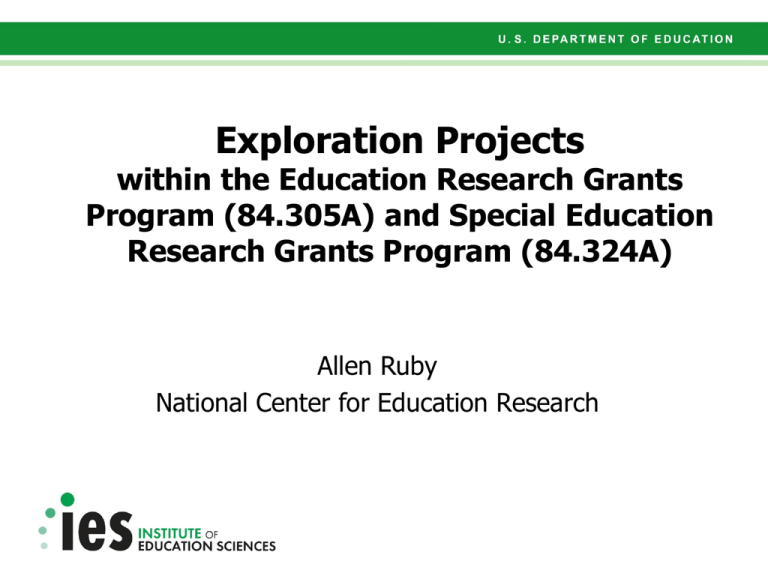
Exploration Projects within the Education Research Grants Program (84.305A) and Special Education Research Grants Program (84.324A) Allen Ruby National Center for Education Research Information for Applying Requests for Applications Letter of Intent IES Grants.gov Application Submission Guide Application Package Requests for Applications (RFA) • A separate RFA for each grant program (84.305A and 84.324A) • Describes the requirements for an application • Requests for Applications are available on: http://ies.ed.gov/funding • To be informed about the release of future RFAs, sign up for the IES Newsflash: http://ies.ed.gov/newsflash/ Letter of Intent (LOI) • A short description of your intended application – PI, institution, collaborators – Budget – rough estimate – Up to 1 page abstract describing the work • Purpose – Used by program officers to discuss your idea – Used by IES Office of Standards and Review to plan for peer review process – Not used in the peer review process – superseded by your application • Submitted on http://iesreview.ed.gov Application Packages • Contains the forms to be filled out and submitted as your application • Available at www.grants.gov – Help: support@grants.gov or 1-800-518-4726 • For the June 23, 2011 application deadline, packages will be available starting April 21, 2011 • For the September 22, 2011 deadline, packages will be available starting July 21, 2011 • Packages are specific for grant program and deadline IES Grants.gov Application Submission Guide • Instructions for completing and submitting the application package • Available on http://ies.ed.gov/funding Key Dates Application Letter of Intent Deadline Due iesreview.ed.gov Application Package Available Start Dates www.grants.gov 6/23/11 4/21/11 4/21/11 3/1/12 to 9/1/12 9/22/11 7/21/11 7/21/11 7/1/12 to 9/1/12 Education Research Grants Program (84.305A) Special Education Research Grants Program (84.324A) Grant Topics • All applications to 84.305A and 84.324A must be directed to a specific topic • Identify the appropriate topic for your work – Read the Topic sections of the Request for Applications (RFA) – Discuss with the appropriate program officer (listed in the RFA) Education Research Topics (84.305A) • • • • • • • Reading and Writing Mathematics and Science Education Cognition and Student Learning Social and Behavioral Context for Academic Learning Education Technology Effective Teachers and Effective Teaching Improving Education Systems: Policies, Organization, Management, and Leadership • Postsecondary and Adult Education • Early Learning Programs and Policies • English Learners Special Education Research Topics (84.324A) • • • • • • • • • • • Early Intervention and Early Learning in Special Education Reading, Writing, and Language Development Mathematics and Science Education Social and Behavioral Outcomes to Support Learning Transition Outcomes for Special Education Secondary Students Cognition and Student Learning in Special Education Professional Development for Teachers and Related Service Providers Special Education Policy, Finance, and Systems Autism Spectrum Disorders Technology for Special Education Families with Children with Disabilities Grant Research Goals • All applications to 84.305A and 84.324A must be directed to a specific research goal (1 of 5) • The goal describes the type of research to be done • As a result, every application is directed to a specific topic/goal combination – Note topic and goal on your application (e.g., at top of abstract) The 5 Research Goals • Exploration – • Development and Innovation – • Evaluate an intervention under ideal conditions Scale-up Evaluation – • Develop a new or modify an existing intervention Efficacy and Replication – • The focus of this webinar Independently evaluate an intervention under routine conditions Measurement – Develop and/or validate a measure The Exploration Goal Before Development Work Begins... Need to understand the problem: • Examine the underlying processes that affect education outcomes • Look for malleable factors that might be targets for interventions • Identify what distinguishes between effective and less effective practices Before Evaluation Begins... Identify education interventions or components of them that appear promising due to their association with improved student outcomes before committing resources to evaluation In a Nut Shell... Development work and some evaluations begin with Exploration Projects that examine underlying processes for the purpose of informing the development of new interventions, modifying existing interventions, or identifying promising interventions for evaluation Exploration • Explore the association between malleable factors and education outcomes – A malleable factor can be changed by the education system be it a characteristic of students (e.g., skills, behaviors), teachers (e.g., credentials, practices) or school (e.g., climate, size) , or an education program or policy • Underlying processes that enhance or inhibit learning • Aspects of a school, district, or community associated with beneficial education outcomes • Education interventions associated with beneficial education outcomes (e.g., professional development, curricula, policies) • Explore factors that mediate or moderate the relationship between malleable factors and student outcomes Education Outcomes are for Students Preschool • School readiness • Developmental outcomes for infants and toddlers with disabilities Kindergarten through Grade 12 • Academic outcomes in reading, writing, math and science • Behaviors, interactions, and social skills that support learning in school and successful transitions to post-school opportunities • High school graduation • Functional outcomes that improve educational results, transitions to employment, independent living, and postsecondary education for students with disabilities Education Outcomes (continued) Postsecondary • Access, persistence, completion • Achievement in gateway math & science courses • Achievement in introductory composition courses Adult Education • Reading, writing, and math for basic and secondary education and English Language Learners Exploration Projects Should • Identify underlying processes that enhance or inhibit learning. These may contribute to the development or modification of interventions • Identify education interventions that may deserve rigorous evaluations • Identify factors that mediate or moderate the underlying processes or the interventions • Generate hypothesis concerning causal relations between factors and outcomes • Contribute to theories of action Exploration Projects Should NOT • Test the efficacy of education interventions • Examine non-malleable factors • Examine malleable factors outside the control of the school system The Application’s Research Narrative • Key part of your application • 4 Sections – – – – Significance Research Plan Personnel Resources • Each section scored and an overall score given • Requirements vary by topic & research goal • 25 pages, single spaced Significance Section • Describes the overall project – The research question to be answered – The malleable factors, moderators, and mediators to be examined • Rationale for the work – Theoretical justification • Logic Models, Change Models – Empirical justification • Related work – Practical justification • importance of the variables (malleable factors, mediators, moderators, outcomes) Significance Section • How work will lead to useful next step – Development or modification of interventions to address the identified malleable factors or underlying process to improve student outcomes – Identification of interventions for more rigorous evaluation • Overall importance Significance – 2 Problems Often Seen in Applications • Unclear theory of change – Why should the malleable factor be related to improved outcomes – A well laid out theory of change makes clear what is expected to happen and in what order – Easy for reviewers to understand research plan – why measure certain outcomes – Graphic can be helpful – e.g. a logic or change model Significance – 2 Problem Areas • Unclear Description of Intervention – What the intervention is • Many components and may be applied at different times – how fit together – Graphic may help – Intervention not shown to be strong enough to expect an impact • Informational • Ensure fidelity – Overly focused on actions not content • Ex.: 20 hours of PD held over 10 weeks but no detail on what is to be covered in the sessions Research Plan • Describe the work you intend to do – How you will answer your research question • Make certain the Research Plan is aligned to Significance section – All research questions should have justification in Significance. • Step-by-step process – Timeline to show when everything will be done All Research Plans Should Include • Clear, concise hypotheses or research questions • Well-specified relations between hypotheses, measures, and independent & dependent variables • Clear description of data sources • Detailed descriptions of data analysis procedures The Research Plan Should Describe • Setting • Population and sample – Sampling plan: inclusion and exclusion criteria – Size (power issue) and attrition – External validity • Measures – Outcomes • Proximal and distal • Sensitivity – Other measures – Reliability and validity Work May Include • Original data collection with appropriate statistical analyses • Secondary data analysis of existing datasets • Secondary data analysis complemented by primary data collection • Meta-analyses designed to determine moderators or moderators of effects Primary Data Collection • • • • • • Sampling strategy Sample characteristics Variables to be measured Procedures for data collection Procedures for coding data Describe links to secondary data if relevant If observational data are collected • How inter-observer reliability maintained • How data be coded • How will data be quantified to support prediction of relation between what was observed and outcomes of interest Secondary Data Use • Database(s) – – – – Sample characteristics Variables to be used Access to and permission to use the data Linking if multiple datasets used • Malleable factor • Outcome variables • Mediators & moderators Exploration Work is Non-Causal • Descriptive analysis • Statistical correlational analysis – Can include more complex methods to address selection issues • Mediation analysis Meta-analysis • Criteria for including or excluding studies, and rationale • Search procedures used • Coding scheme & procedures for extracting data from studies • Procedures for ensuring reliability of the coding Meta-analysis • Demonstrate that sufficient numbers of studies are available to support meta-analysis • Demonstrate that relevant information is reported frequently enough that a database can be constructed • Clearly describe effect size statistics, associated weighting functions, procedures for handling outliers, and any other adjustments Research Plan: Analysis • • • • • • • • Describe how analysis answers research questions Show your models Address clustering Describe how missing data will be handled Check for equivalency of groups at start of study Track attrition and check for attrition bias Describe sensitivity tests of assumptions Describe analysis of qualitative data and links to quantitative analysis Personnel Section • Describe key personnel – Link each person and their expertise to their role in project - show that every aspect of project has person with expertise to do it • • • • Methodologists: show expertise in particular method to be used Substantive person for all issues addressed Do not propose to identify and hire key people after grant awarded Project management skills – Give time contribution for each - show that every aspect has enough time from expert • Orient CVs same way – specific to project – 4 pages plus 1 page for other sources of support Personnel Requirements • Publication record and projected publications from this grant are considered • Developers should discuss past success getting developed interventions evaluated • If previous IES grant, discuss results • Evaluations require attention to objectivity should a developer or persons with financial interest be involved – Efficacy projects: address how objectivity maintained – Scale-Up: Independent evaluation: developer can provide routine implementation support Personnel Strategies for PI • Senior Researcher – Show adequate time to be PI – Make credentials clear: not all reviewers may know • Junior Researcher as PI – Show adequate expertise not only to do work but to manage project – Reviewers may be more comfortable if you have senior person(s) on project to turn to for advice Resources • Show the institutions involved have the capacity to support the work – Do not use university boilerplate • Show that all organizations involved understand and agree to their roles – What will each institution, including schools, contribute to the project – Show strong commitment of schools and districts – Have alternatives in case of attrition Resources (continued) • Appendix C should back this up with – Detailed Letters of Support from research institutions, States, districts, schools • Data issues – Document permission to use and access to confidential data (letters in Appendix C) – Show familiarity with data – show that it can be used to do the proposed work – If merging datasets, show that it can be done Appendices • Appendix A (15 page limit) – Figures, charts, and tables – Examples of measures – 3 pages to address past reviewer comments or to argue that a proposal is a new submission • Appendix B (10 page limit) – Examples of materials used in an intervention or assessment • Appendix C (no page limit) – Letters of agreement (districts, schools, data providers, other partners, consultants) – Clearly state responsibilities of the writer Budget and Budget Narrative • Provide a clear budget and budget narrative for overall project and each sub-award • IES Grants.gov Application Submission Guide describes budget categories • Check RFA for specific budget requirements for Research Goals and Grant Programs • Ensure agreement among Research Narrative, Budget, and Budget Narrative Award Information – Secondary data analysis or meta-analysis: • Typical $100,000 to $300,000 per year (direct and indirect) • Maximum 2 years and $700,000 – Primary data collection and analysis (with or without a secondary data analysis): • Typical: $100,000 to $400,000 per year • Maximum 4 years and $1,600,000 Grant Submission • • • • • Make sure your institution is registered on grants.gov Complete your online forms and upload PDFs Authorized representative completes the process Submit by 4:30:00 EST on deadline – earlier is safer If problems uploading – Contact Help Line 1-800-518-4726 and get a case number • You should receive four emails – – – – Grants.gov: assigns you a number that starts with GRANT Grants.gov: your application is validated or rejected due to errors. If the latter, correct and resubmit until validated. Dept. of Ed: retrieved your application from Grants.gov Dept. of ED: assigns you a number that starts with R305 or R324 Application Review) • • • • Carried out by the IES Office of Standards and Review Compliance screening for format requirements Responsiveness screening to topic and goal requirements Assigned to review panel – 2-3 reviewers (substantive and methodology) – If scored high enough, application is reviewed by full panel • Many panelists will be generalists to your topic • There will an expert in every procedure you use – Overall score plus scores on Significance, Research Plan, Personnel, and Resources • Resubmissions encouraged: address comments Peer Review Process Information http://ies.ed.gov/director/sro/peer_review/index.asp Notification • All applicants will receive e-mail notification of the status of their application • All applicants receive copies of reviewer comments • If you are not granted an award the first time, plan on resubmitting and talk to your program officer Final Reminders • • • • Start early Read the Request for Applications Talk with the program officer Start the online submission process early ies.ed.gov Allen Ruby allen.ruby@ed.gov
